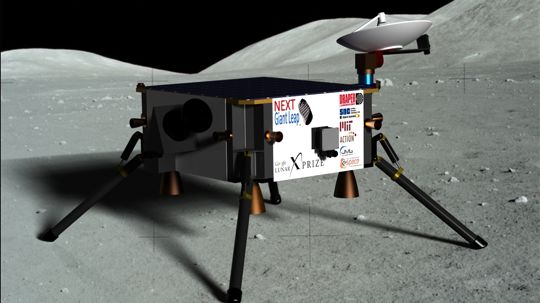 Next Giant Leap in Boulder, Colorado— a startup that’s making robots that will land and hop around on the surfaces of other planets in order to gather data, detect resources valuable to humans, and more — attained a $1 million grant from the Charles Stark Draper Laboratory, to advance their technology and pursue the $30 million Google Lunar X Prize in 2012, the companies revealed today.
Next Giant Leap in Boulder, Colorado— a startup that’s making robots that will land and hop around on the surfaces of other planets in order to gather data, detect resources valuable to humans, and more — attained a $1 million grant from the Charles Stark Draper Laboratory, to advance their technology and pursue the $30 million Google Lunar X Prize in 2012, the companies revealed today.
Draper is a non-profit in Cambridge, Massachusetts that develops advanced technology, and assists and invests in others’ innovation for space, air, land and sea exploration. One of Next Giant Leap’s team members, Seamus Tuohy (also Draper’s director of space systems) explained what NGL is working on and its potential uses:
“We’re developing critical technology for landing and hopping, both to satisfy the rules for the Google Lunar X Prize, and to provide an innovative, regional-scale science measurement capability. Unlike rovers that go to a single point on the surface of a planet, and then maybe two kilometers away and back, retreating if something is in the way, these would land, then ascend a bit, do a translation, traverse above the terrain to land in another spot. The lander-hopper we’re building is about the size of a coffee table, not a car.
I believe this would be particularly valuable to the environmental cause. The future ability to monitor the environment is a government concern, but who’s to say the best technology and services to measure greenhouse gases, and other things might not come from a commercial enterprise like Next Giant Leap? These technologies we’re working on let you place sensors, gather samples from difficult-to-access locations on the moon, and on earth as well where you don’t want to send a manned vehicle or a helicopter.”
Another team member with NGL, Todd J. Mosher, a program manager at Sierra Nevada Corporation, said potential buyers of NGL’s lander technology could include NASA as an anchor, and a number private sector companies that look at the moon as the next Gold Rush site, full of untapped water and mineral resources that are becoming increasingly scarce and expensive on earth.
Mosher and Tuohy envision NASA using NGL’s landers in “operations-to-station” and “commercial crew development” programs, bringing people and their supplies to the surface of the moon and back, or in scientific investigations. NASA, however, is not in the practice of mining other planets for resources Mosher noted. Beyond government missions, he explained, his team’s lander technology and more so, competitions like the Google Lunar X Prize, could have a huge impact on clean energy, water and minerals trade:
“My kids are doing an explorers’ segment in school right now, studying Magellan, Ponce de Leon and those folks. If you study that history, the first wave of explorers were funded by the government. They went out and found places. The next waves were entrepreneurs and traders who turned scientific discoveries into something profitable. They may not be as glamorous, but what they did led to the development of trade routes that connected people, and allowed settlements that turned into great cultures.
NGL’s landers are robotic scouts or prospectors that will head out to new territories to discover forms of wealth for all of us. They depend on solar rays to get their power. So does a lot of space technology, actually. They’re part of the next wave that will make space exploration much more sustainable. They can also help us explore water deposits that are believed to be in cold traps, or craters on the surface of the moon that the sun doesn’t reach.
The competition is driving people to get together and figure things out. We may not solve this problem in our first mission, but we’re thinking about how to survive a lunar night, which is equivalent to 14 days on earth in darkness, if our vehicles and stations run on solar. If we develop something rugged and robust enough to work in that extreme environment, it will help us back here on earth.”
With this grant, the NGL team, led by founder Michael Joyce, has raised about $1.5 million, including an investment of $200,000 by the team’s founder Michael Joyce, a $100,000 from Jolted Media Group Ltd., a $30,000 grant from eSpace an incubator program for space startups, and $125,000 from Sierra Nevada Corporation.
